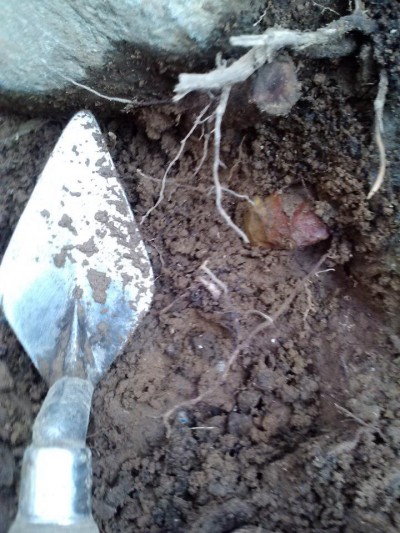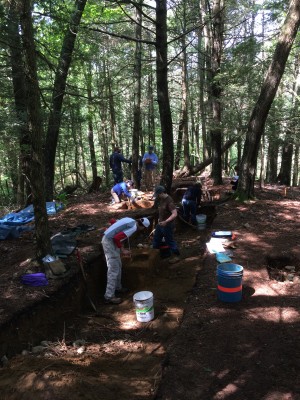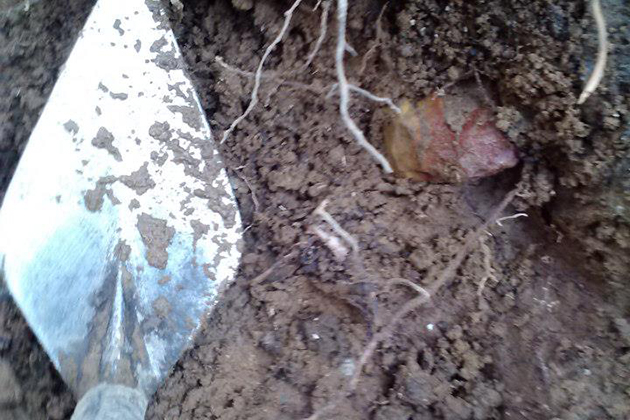
About 12,000 years ago, when ice sheets in the Northern Hemisphere had almost finished melting and the last ice age was coming to an end, a group of Paleoindians camped along the edges of what today is the Great Cedar Swamp at the center of the Mashantucket Pequot Reservation.
Expert flint knappers or makers of stone tools, these early New Englanders left a treasure trove of history buried in the ground. Hundreds of their artifacts have recently been uncovered through archaeological excavation, a joint venture of the Mashantucket Pequot Museum and Research Center and the University of Connecticut.
“This site is part of an important emerging Paleoindian landscape, and one of the earliest and most extensive ever identified,” says Kevin McBride, associate professor of anthropology at UConn and director of research at the Mashantucket research center, who is leading the project.
When the excavation began two years ago, initial archeological evidence suggested the site belonged to hunter-gatherers from a later period. Yet, as the dig yielded distinctive stone-tool Paleoindian artifacts, scientists determined the site to be the oldest of four Paleoindian campgrounds documented so far on the reservation, and quite possibly the oldest in Connecticut.
“These sites are rare and hard to find,” McBride says, “but we’re finding a lot of evidence that many are scattered around the reservation, as these early people came and went from the region over a 1,000-year period.”
To date, researchers have identified more than 250 potential archeological sites on tribal property, underscoring the region’s increasingly important role for studying the origins and ways of life of these earliest colonizers of North America.
Back then, the Mashantucket swamp was a drained glacier lake probably inhabited by a diverse flora and fauna, including caribou, waterfowl, and wetland plants, that the ancient Paleoindian population would have relied upon to survive. Because Connecticut’s soil is acidic, stone tools and other stone remnants are all that remain for archeologists to uncover, yet they are key to identifying these historically distant campsites and to understanding the Paleoindian way of life.
Artifacts the archeologists have found at the excavation site include 85 tools, specifically hunting spear tips made in the Paleoindian “fluted point” style; blade-like stone flake tools used to butcher, scrape, and tan hide; and stone gravers, tools with little spurs that were used to shape eyelets in antlers while making bone needles to tailor clothes from animal hides.
“The environment was a lot colder then, so having hide clothing would have been a necessity,” says Zachary Singer, a fifth-year UConn archeology graduate student supervising the day-to-day Pequot Cedar Swamp dig.
In addition to the tools, the team has found more than 900 flakes, or shards of chipping debris, from the production of stone tools. All of the artifacts will eventually be displayed at the Mashantucket Pequot Museum.
“We’re building a story,” Singer says. “We’re trying to reconstruct a campsite that people made 12,000 years ago, based on the trash they threw away. Our goal is to get a fuller picture of what these people were doing, and the best way to do that is by finding their stuff.”
Being the first person to see a stone tool that was last used 12,000 years ago is a unique experience. — Zachary Singer, graduate student in archeology
The Paleoindians were highly nomadic, and when they migrated, they carried specific types of stones so that skilled craftsmen could break and shape them into tools, an ongoing activity at their campsites, Singer explains. Using forensic scientific techniques to determine their geographic origin, archeologists have traced these transported stones to Pennsylvania, New York, and even a lake in northern Maine.
“Based on that evidence, we’ve learned these people were traveling great distances throughout the New England and mid-Atlantic region, or were in contact with other people who provided them with quality stones,” he says. “It shows that highly integrated social networks existed, even at that early stage when Paleoindian people were still discovering the landscape and types of resources there were in New England.”
The stones reveal another interesting clue about the Paleoindians: “Based on discarded stone chips found in different piles around the site,” Singer says, “we’ve been able to reconstruct that the areas where they made hunting tools were separated from where they maintained scraping tools, so we’re likely seeing campsite organization 12,000 years ago.”
Researchers have excavated more than 500, 1 x 1 meter squares at the campsite with a team that ranges from four to 15 archeologists. Each square takes two experienced archeologists an average of two days to excavate.

Also helping are students from UConn’s six-week archaeological field school, where participants gain hands-on experience in meticulously documenting excavation sites, and learn how to pick out significant stone artifacts from other glacially deposited rocks being sifted through a screen with a 1/8th-inch wire mesh.
The extra pairs of hands are helping expand the research. For example, routine archeological surveys at the Mashantucket swamp have uncovered “hints” of additional Paleoindian sites. Most haven’t been excavated thoroughly, so Singer has the field school students digging down further. Currently the UConn team is excavating what Singer believes may be another 12,000 year-old Paleoindian site.
“These are very rare, so it’s like finding a needle in a haystack,” he says. However, the student archeologists have already recovered chips of the high-quality stone types used to make stone tools. Uncovering any fluted-point hunting tools, or blade-like flake artifacts distinctive of the Paleoindian period, would confirm the site’s origin.
Singer says he’s confident it’s just a matter of time until they are able to prove they have discovered another 12,000 year-old site.
“Being the first person to see a stone tool that was last used 12,000 years ago is a unique experience,” he adds. “That’s what keeps me coming out every day. I never know when I’ll see something I’ve never seen before.”



